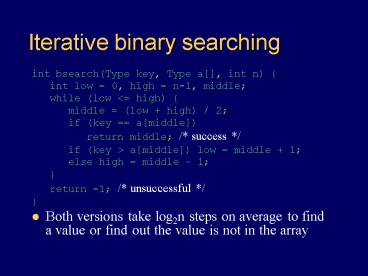Iterative binary searching PowerPoint PPT Presentation
1 / 8
Title: Iterative binary searching
1
Iterative binary searching
- int bsearch(Type key, Type a, int n)
- int low 0, high n-1, middle
- while (low lt high)
- middle (low high) / 2
- if (key amiddle)
- return middle / success /
- if (key gt amiddle) low middle 1
- else high middle 1
- return -1 / unsuccessful /
- Both versions take log2n steps on average to find
a value or find out the value is not in the array
2
Towers of Hanoi and 8 Queens
- Move n disks from a to c use b to hold
(demo) - void tower(int n, int a, int b, int c)
- Base case just one disk trivial
- if (n1) moveOneDisk(a?c)
- General case assume a method that can move a
tower of height n-1. This method!!! - else
- tower(size n-1, a?b with c holding)
- moveOneDisk(a?c)
- tower(size n-1, b?c with a holding)
- One more example 8 queens problem
3
Sorting
- Probably the most expensive common operation
- And maybe the most studied CS problem
- Problem arrange a0..n-1 by some ordering
- e.g., in ascending order ai-1ltai, 0ltiltn
- Two general types of strategies
- Comparison-based sorting includes most
strategies - Lots of simple, inefficient algorithms
- Some not-so-simple, but more efficient algorithms
- Address calculation sorting rarely used in
practice - But very fast if the data are suitable
4
Selection sort
- Idea build sorted sequence at end of array
- At each step
- Find largest value in not-yet-sorted portion
- Exchange this value with the one at end of
unsorted portion (now beginning of sorted
portion) - Easy to do (see text p. 629), but complexity is
O(n2) - Huh?
5
Big-Oh notation
- A way to compare algorithms just algorithms
- All but the dominant term are ignored
- e.g., say algorithm takes 3n2 15n 100 steps
(problem of size n) 1st term dominates for
large n - Constants are due to processor speed, compiler,
language features, so ignore the 3 - Means this example algorithm is O(n2)
- Pronounced Oh of n-squared a.k.a., it is in
the quadratic complexity class of algorithms
6
Some complexity classes
- Linear - O(n) Quadratic - O(n2) Cubic - O(n3)
- Also slower than cubic e.g., Exponential -
O(2n) - And faster than linear O(log n), and Constant -
O(1)
7
mergeSort
- A divide and conquer sorting strategy
- Idea (1) divide array in two (2) sort each
part (3) combine two parts to overall solution - mergeSort has a naturally recursive solution
- if (more than one item in array)
- divide array into left half and right half
- mergeSort(left half) mergeSort(right half)
- merge(left half and right half together)
- Requires helper method to merge two halves
- Actually where all the work is done (p. 640)
- Complexity is O(n log n)
- i.e., lots faster than selectionSort
8
How much faster is lots faster?
- Use a stopwatch to get some idea
- See SelectionSortTimer
- Of course actual times depend on
- But MergeSortTimer is clearly much faster
- Moral sometimes it pays to apply a better
algorithm despite the extra effort.

